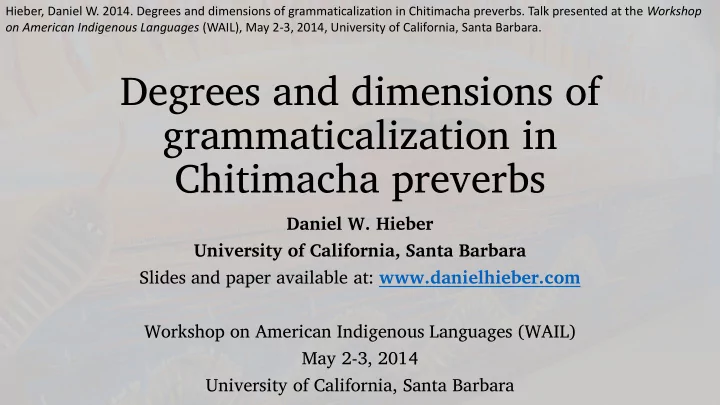

Hieber, Daniel W. 2014. Degrees and dimensions of grammaticalization in Chitimacha preverbs. Talk presented at the Workshop on American Indigenous Languages (WAIL), May 2-3, 2014, University of California, Santa Barbara. Degrees and dimensions of grammaticalization in Chitimacha preverbs Daniel W. Hieber University of California, Santa Barbara Slides and paper available at: www.danielhieber.com Workshop on American Indigenous Languages (WAIL) May 2-3, 2014 University of California, Santa Barbara
Dimensions of Grammaticalization • Frequency • Productivity • Syntactic independence • Lexicalization • Semantic compositionality • Functional renewal • Phonetic reduction
The Chitimacha corpus # of texts 88 # of paragraphs 418 # of sentences 3,496 # of lexical entries (lexemes) ~3,724 # of unique words (types) 4,467 # of words (tokens) 29,028
Preverbs layering kas tʼuːtʼšnɑʔa • variation in syntactic back you.go • boundedness ‘you (pl.) are going back’ TMESIS • functional divergence • kap nacpikminaqa up they.began ‘they started up’
Chitimacha Preverbs ʔap (to) here, coming returning here, together, randomly, ʔapš reflexive, reciprocal hi (to) there, going undoing, returning, doing in response, doing his again kap up, suddenly, inceptive, inchoative, statives kaːpʼs returning up kas returning there, reverse, apart down, thing, detransitivizer, nominalizer, ni imperative
Historical origins of Chitimacha preverbs Reversative * -š / -s • ʔap ‘here’ → ʔapš ‘returning here’ • hi ‘there’ → his ‘do in response’ (< ‘back there’) • kap ‘up’ → kaːpʼs ‘back up’ • ni ‘thing’ → ni DTRZR • • * kaʔ ‘extending across’ + - š REV → kas ‘returning back’ hi POSTP ‘to’ → hi ‘to there’ • e.g. ni tiːkmiš hi koːnaka Governor to we.called (A03e.2) • *kaːp ‘up’ → kap ‘up’ (cf. kaːpte- ‘sprout’) ʔap ‘come’ ??? → ʔap ‘here, coming here’ •
Unifying Features of Chitimacha Preverbs Phonology: do not phonologically attach to verb / other words • Phonotactics : monosyllabic, short vowels, CVC / CV{k/p}S • Prosody: part of the same prosodic group as the verb • Paradigmaticity: ʔap ‘to here’ vs. ʔapš ‘returning here’, etc. • mutually exclusive with each other (with lexicalized exceptions ) • Syntax: all occur in same preverbal slot • adverbs don ’t appear here (and are always bimorphemic) • Semantics: all share a directional sense as a core meaning • Lexicon: frequently form a lexicalized unit with the verb •
Degrees of grammaticalization: Frequency % of Preverb Frequency Rank in Corpus Occurrences hi 1298 33.50 % #2 kap 775 20.00 % #3 ni 646 16.67 % #5 ʔapš 462 11.92 % #8 ʔap 335 8.65 % #14 kas 279 7.20 % #17 his 74 1.91 % #51 kaːpʼs 6 0.15 % #534
Degrees of grammaticalization: Productivity # of Verbs Preverb Co- % of Verbs Preverb Preverb occurs With Co-occurs With ni 195 25.42 % hi 190 24.77 % kap 154 20.08 % ʔapš 82 10.69 % kas 67 8.74 % ʔap 57 7.43 % his 20 2.61 % kaːpʼs 2 0.26 %
Tmesis hus waši kiːctiš we piyi ših ki hi nam čʼahtʼiši her thumb those cane joints LOC to brand it.hews ‘Her thumb print is embossed in those cane joints.’ (A13e.2) lit. ‘Her thumb print hews a brand in those cane joints.’ hi kayi ʔučičuy to life you.will.do ‘you will live ’ ( lit. ‘you will do a life ’)
Degrees of grammaticalization: Syntactic independence hi: 23 cases ni: 2 cases hi ney nučminaʔa ni kač hamčiːkʼ there land they.worked thing fortune having ‘they buried him’ (A35a.2) ‘having (good) luck’ (A10k.2) ʔapš: 4 cases kas: 1 case ʔapš ni nektmaːšnaʔa kas panš teykʼš together DTRZR they.leagued back person turning ‘they leagued together (as with ‘turning back into a person’ an animal spirit guide)’ (A67a.11) (A35d.15)
Degrees of grammaticalization: Syntactic independence naːkšte- , naːkšt- ‘write’ haːkšte- , haːkšt- ‘write, draw’ napʼe- ‘be raw’; napščʼe- ‘be black’ hapt ‘vermillion’; * haps ̌ ‘black’ nakst- ‘sell’ ʔakst - , ʔaks - ‘buy’ naši- , našma- ‘hunt’ haši- , hašma- ‘stalk, hunt’ neːmi - ‘be scared’ ʔem - ‘fear’ nečʼin ‘temple’ hečʼi- ‘be holy’ nekt- ‘skin, peel’ (tr.) haki- ‘peel’ (tr.) nitʼi - , niyaʔ - ‘believe’ (both forms have ni in common) nih- ‘turn over’ ʔiy - ‘turn’; ʔiht - ‘circle’ niːnšt- ‘turn upwards’ ʔiːnšt- ‘upturn’ (tr.) niki ‘real’ ʔiki - ‘hide’ nokt- ‘permit, release’ hokt- ‘leave, permit, release’ nokun ‘shoulder’; mokun ‘knee’ ʔokun ‘shoulder’ nuki- ‘pray’ huːka ‘prayer’
Degrees of grammaticalization: Semantic compositionality kap 183 ʔapš 127 ni 114 kas 64 hi 30 his 15 kaːpʼs 3 ʔap 2
Degrees of grammaticalization: Functional renewal • =nk – locative (among other uses) we seːni =nk hi ničwinkiš the pond =LOC to when.he.came.to.water ‘when he got to the edge of the pond’ (A01a.3) hɑ =nk ʔap nemnaʔa this =LOC here they.crossed.water ‘they crossed over [water] to here’ (A02c.1)
Degrees of grammaticalization: Functional renewal % of Cases Where Preverb Preverb Appears with =nk kas 21.15 % hi 11.02 % his 10.81 % ʔap 6.87 % ni 6.19 % kap 5.29 % ʔapš 3.90 % kaːpʼs 0.00 %
Compositionality Incorporation Productivity Frequency Renewal Tmesis More grammaticalized hi ni ni kap kas other kap hi ʔ ap ʃ hi ni kap ni his ʔ ap ʃ ʔ ap ʃ kas ʔ ap ʔ ap kas kas hi ni other kas ʔ ap ni his kap his his ʔ ap ʃ kaːpˀs ʔ ap ʃ kaːpˀs kaːpˀ s hi ʔ ap kaːpˀs Less grammaticalized
Conclusions 1. Constructions are grammaticalized in different ways to varying degrees – not a monolithic process 2. No one process is sufficient for grammaticalization – only when these processes converge sufficiently do we recognize it 3. Grammaticalization is less about unidirectionality and more about unity in change – the extent to which these processes happen in tandem
Thank you! Slides and paper available at: www.danielhieber.com
Recommend
More recommend